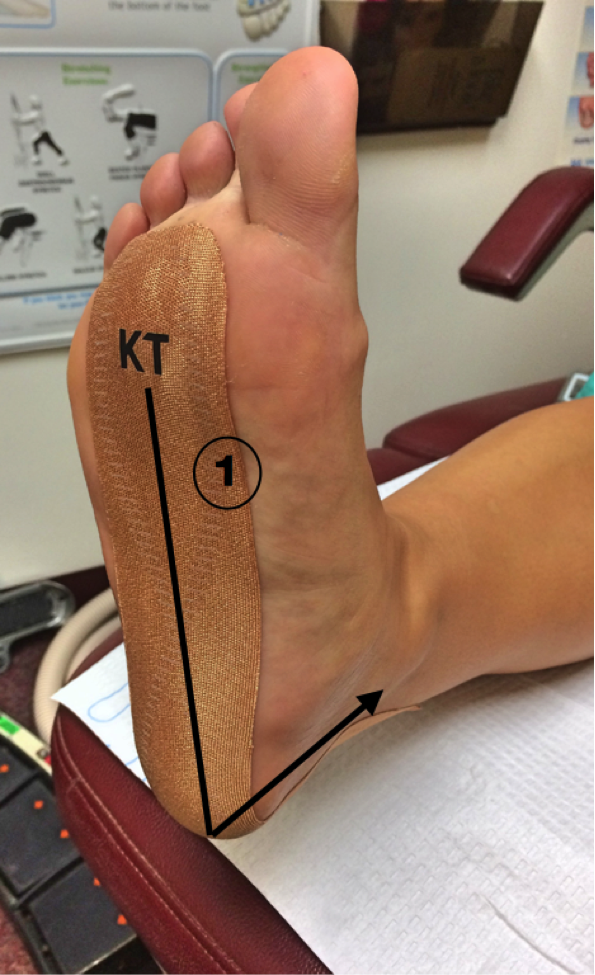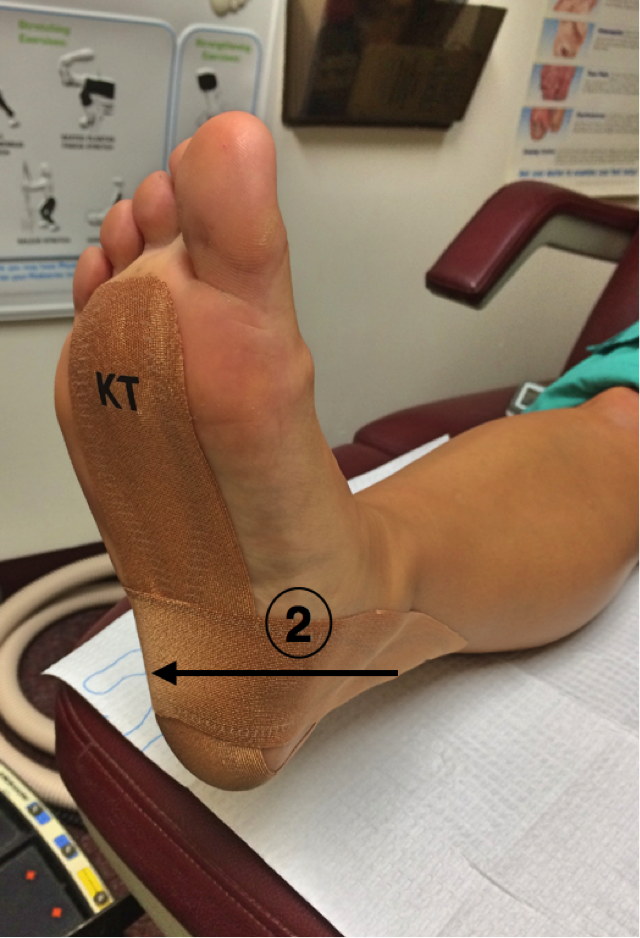ADVERTISEMENT
How Lower Extremity Kinesiology Taping Can Keep Athletes Competing
 Kinesiology or “elastic therapeutic” taping is in widespread use by athletes today as a means of both treatment and prevention of sports-related injuries.1 The tape has properties designed to mirror human skin. It is engineered to stretch up to 140 percent of its resting length while remaining about the thickness of the epidermis.1,2 Kinesio Tape (Kinesio Holding Corporation) is composed of cotton with an acrylic, heat-activated adhesive backing, allowing it to stay in place for up to one week.3 Kinesio Tape dries quickly and will not fall off from excessive sweat. I have used KT Tape (KT Health) in my practice (see photos).
Kinesiology or “elastic therapeutic” taping is in widespread use by athletes today as a means of both treatment and prevention of sports-related injuries.1 The tape has properties designed to mirror human skin. It is engineered to stretch up to 140 percent of its resting length while remaining about the thickness of the epidermis.1,2 Kinesio Tape (Kinesio Holding Corporation) is composed of cotton with an acrylic, heat-activated adhesive backing, allowing it to stay in place for up to one week.3 Kinesio Tape dries quickly and will not fall off from excessive sweat. I have used KT Tape (KT Health) in my practice (see photos).
What makes Kinesio Tape unique in comparison to other athletic tape is its elasticity. Athletes apply the tape by stretching it slightly before rubbing it on to the skin. This allows the tape to recoil, creating a pulling-type force on the skin. This pulling force on the skin theoretically elevates the skin from the underlying muscle.2
 Advocates of Kinesio Tape cite many proposed benefits.1,4 These include reduced muscle fatigue, pain inhibition, enhanced proprioception, reduced edema and improved lymphatic drainage. Thelen and colleagues performed a study comparing Kinesio Tape to sham tape on the shoulders of those who were clinically diagnosed with rotator cuff tendonitis or impingement.1 They concluded that Kinesio Tape may be beneficial in reducing pain with active range of motion immediately after application in comparison to sham tape. Another report by Gonzalez-Iglesias and colleagues found that the Kinesio Tape group had a greater decrease in pain based on a numerical pain rating scale in comparison to sham taping for patients with acute whiplash-associated disorders.4
Advocates of Kinesio Tape cite many proposed benefits.1,4 These include reduced muscle fatigue, pain inhibition, enhanced proprioception, reduced edema and improved lymphatic drainage. Thelen and colleagues performed a study comparing Kinesio Tape to sham tape on the shoulders of those who were clinically diagnosed with rotator cuff tendonitis or impingement.1 They concluded that Kinesio Tape may be beneficial in reducing pain with active range of motion immediately after application in comparison to sham tape. Another report by Gonzalez-Iglesias and colleagues found that the Kinesio Tape group had a greater decrease in pain based on a numerical pain rating scale in comparison to sham taping for patients with acute whiplash-associated disorders.4
 In the lower extremity, there are many common ailments for which athletes can use the tape. These conditions include plantar fasciitis, Achilles tendonitis and medial tibial stress syndrome. Figures 1 to 4 demonstrate the application of kinesiology tape in a patient with plantar fasciitis. A case study by Lee and Yoo found that repeated application of Achilles tendon kinesiology taping resulted in increased active ankle joint range of motion and decreased tenderness in a patient with non-insertional Achilles tendon injury.5 Unfortunately, there are few studies that prove the efficacy of Kinesio Tape in other areas as most of the evidence remains anecdotal.2,6
In the lower extremity, there are many common ailments for which athletes can use the tape. These conditions include plantar fasciitis, Achilles tendonitis and medial tibial stress syndrome. Figures 1 to 4 demonstrate the application of kinesiology tape in a patient with plantar fasciitis. A case study by Lee and Yoo found that repeated application of Achilles tendon kinesiology taping resulted in increased active ankle joint range of motion and decreased tenderness in a patient with non-insertional Achilles tendon injury.5 Unfortunately, there are few studies that prove the efficacy of Kinesio Tape in other areas as most of the evidence remains anecdotal.2,6
 Nonetheless, Kinesio Taping has continued to rise in popularity. Though there is not a significant amount of evidence in the literature to support the use of Kinesio Tape, it is gaining acclaim among high-level athletes. With endorsers like Houston Rockets shooting guard James Harden and Olympic Gold medalist Kerri Walsh, Kinesio Tape is sure to receive attention from patients.7 As Kinesio Tape becomes more prevalent in the public eye, patients will become more and more interested in this technique for non-surgical management of foot and ankle pathologies. Patients can easily apply Kinesio Tape once a week in an office setting and it has the potential to be a valuable addition to your conservative treatment regimen.
Nonetheless, Kinesio Taping has continued to rise in popularity. Though there is not a significant amount of evidence in the literature to support the use of Kinesio Tape, it is gaining acclaim among high-level athletes. With endorsers like Houston Rockets shooting guard James Harden and Olympic Gold medalist Kerri Walsh, Kinesio Tape is sure to receive attention from patients.7 As Kinesio Tape becomes more prevalent in the public eye, patients will become more and more interested in this technique for non-surgical management of foot and ankle pathologies. Patients can easily apply Kinesio Tape once a week in an office setting and it has the potential to be a valuable addition to your conservative treatment regimen.
References
- Thelen MD, Dauber JA, Stoneman PD. The clinical efficacy of kinesio tape for shoulder pain: a randomized, double-blinded, clinical trial. J Orthoped Sports Phys Ther. 2008; 38(7):389-95.
- Bassett KT, Lingman SA, Ellis RF. The use and treatment efficacy of kinaesthetic taping for musculoskeletal conditions: a systematic review. NZ J Physiother. 2010; 38(2):56-62.
- Available at https://www.kinesiotaping.com/ .
- Gonzalez-Iglesias J, Fernandez-De-Las-Penas C, Cleland JA, et al. Short-term effects of cervical Kinesio taping on pain and cervical range of motion in patients with acute whiplash injury: a randomized clinical trial. J Orthoped Sports Phys Ther. 2009; 39(7):515-521.
- Lee JH, Yoo WG. Treatment of chronic Achilles tendon pain by Kinesio taping in an amateur badminton player. Phys Ther Sport. 2012; 13(2):115-119.
- Williams S, Whatman C, Hume PA, Sheerin K. Kinesio taping in treatment and prevention of sports injuries: a meta-analysis of the evidence for its effectiveness. Sports Med. 2012; 42(2):153-164.
- Available at https://www.kttape.com.











